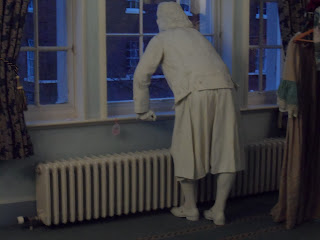Have you caught sight of someone in the corner of
your eye, turned to speak to them, only to find there is no one there? Or perhaps you have seen them walk from one
room to another only for the room to be empty with no other way out of the
room? It is even possible that you could
describe the clothes they were wearing, the style of their hair or the smell of
their perfume or tobacco.
Not all such sightings are solid; some can be
fuzzy, out of focus, wispy or seen as streaks or patches of light. They can come and go at will, appear and
disappear quickly or just fade away.
They can even walk through, what to us is a solid object. These sorts of things are called
apparitions.
Some researchers consider apparitions to be
hallucinations or a state of mind that has no true reality. Others believe they could be a form of
telepathy passing from the dead to the living.
However, while most sightings occur to a single percipient around eight
percent are collective.
Apparitions are classed as collective when
more than one person sees the same thing either independently or
simultaneously, under conditions where collaboration is not possible. In a group situation, if one person sees an
apparition, there is about forty percent likelihood that others will share the perception.
One famous collective apparition occurred on the 2nd
of July 1863 during the fierce Battle of Gettysburg between Union and Confederate forces. As
both sides were taking heavy casualties a single Union soldier suddenly appeared
on a horse. He rode through the battle
field while being repeatedly shot at and although he seemed to be hit many
times, he never fell. This untouchable
soldier eventually disappeared.
Later that same day the Union forces made a final
charge on Little Round Top Hill. As soon
as the charge began the same bulletproof soldier reappeared and rode through
the battlefield before disappearing again.
Union soldiers reported their experiences to
Colonel
Joshua L. Chamberlain, these eventually ended up at the War Department
from where Colonel Pittenger was sent to investigate upon the orders of Secretary
of War Edwin Stanton.
It appears that an official report was never
produced but Colonel Pittenger did document his many interviews with people who
collectively witnessed the ghostly apparition including General Oliver O.
Howard of Maine.
Collective apparitions can also occur in peaceful
times; only a few years ago a small team of ghost hunters reported seeing a
group of four headstones against the outside wall of a ruined Welsh chapel. The headstones were of different heights, one
appeared to be a double or at least two stones standing so close at to touch
and in a neat row. They also appeared to
have writing on them; when one member of the team stepped forward to move the
brambles aside so that the words could be studied in the hope of finding a
name, the headstones are said to have simply vanished.
It is possible that a small group could conspire to
deceive but what about a large group, or people in different places? For instance there is the strange case of
George Roberts.
It was about 09.45hrs while getting ready to go to
church that his mother heard a voice cry out, ‘mother! Mother!’ His father was already at church ringing
the bells when he was positive that there was someone standing behind him,
watching him. When he turned around, no
one was there. Meanwhile around 1,500
miles away in Louisiana, Port Hudson was being attacked by confederate
troops. It is reported that George
Roberts died in that battle at around 10am on June 14th, 1863. It was some time later that his parents were
informed that he had died around the time they had had their experiences.
No other teams visiting that ruined Welsh chapel have
reported seeing such an apparition, and no records of graves have been found
for that chapel so what did they see? If
it was a trick of light and shadow why did they all report the same thing when
they would be viewing it from different angles due to the undulation of the
ground, the narrowness of the track and differences in their own heights? Was it a case of group hallucination?
These are just a few examples of collective
apparitions, the last can also be classed as a Crisis Apparition; an apparition
that occurs when one person is experiencing a crisis or life-threatening
situation and are perceived by another person usually someone who has an emotional
connection to them.
One thing is for certain; reports of such apparitions
will continue to capture the interest of paranormal investigators.




